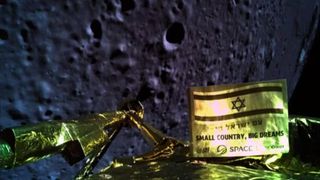
Israel will keep shooting for the moon.
The team behind the nation's Beresheet probe, which crashed during its historic lunar-landing attempt Thursday (April 11), will take another crack at Earth's nearest neighbor.
"We're going to actually build a new halalit — a new spacecraft," billionaire businessman and philanthropist Morris Kahn said in a video statement posted on Twitter by the nonprofit group SpaceIL. "We're going to put it on the moon, and we're going to complete the mission."
Related: Israel's 1st Moon Lander Beresheet in Pictures
The work on Beresheet 2.0 will begin immediately, he added: the team is meeting this weekend to start planning the new project.
Kahn is president of SpaceIL, which built and operated Beresheet along with the company Israel Aerospace Industries. He also funded the mission to a large degree, covering about 40% of its total $100 million price tag.
The dream goes on! Morris Kahn just announced the launching of Beresheet 2.0 #Beresheet2.0 #IsraeltotheMoon pic.twitter.com/fHlo3jeQ4WApril 13, 2019
The 5-foot-tall (1.5 meters) Beresheet, whose name means "in the beginning" in Hebrew, launched to Earth orbit atop a SpaceX Falcon 9 rocket in February.
Get the Space.com Newsletter
Breaking space news, the latest updates on rocket launches, skywatching events and more!
The little robot spent the next six weeks pushing its orbit slowly outward, getting closer and closer to the moon. On April 4, Beresheet was captured by lunar gravity, making Israel just the seventh nation to put a probe in orbit around the moon.
The touchdown attempt came a week later. Success would have granted Israel entry into an even more exclusive club; to date, only the Soviet Union, the United States and China have pulled off a soft lunar touchdown.
And those missions were all government-funded. Beresheet was aiming to become the first privately funded craft ever to explore the moon's surface.
But it wasn't to be. Beresheet suffered an engine glitch during its descent Thursday and slammed into the gray dirt at 310 mph (500 km/h).
SpaceIL started out as an entrant in the Google Lunar X Prize, a $30 million competition designed to spur private space exploration. The GLXP ended last year without a winner, but SpaceIL keep working on its mission, as did several other teams.
X Prize officials announced shortly after Thursday's crash that the Beresheet team will still get a special $1 million award.
"I think they managed to touch the surface of the moon, and that's what we were looking for for our Moonshot Award," said X Prize CEO Anousheh Ansari.
Beresheet's main goals were to advance Israel's space program and to generate excitement about science, technology, engineering and math among young people. And the mission succeeded in both of these aims, even though it didn't nail the landing, Beresheet team members have said.
Indeed, Kahn cited Beresheet's substantial global reach as a reason to try again.
He decided to build Beresheet 2.0 "in light of all the support that I've got from all over the world, and the wonderful messages of support and encouragement and excitement," Kahn said in the video.
- Israeli Lander Failure Marks 1st Moon Crash in 48 Years
- Here's What Mission Control Is Like Before Israel's Beresheet Moon Landing
- Israeli Moon Lander Snaps Epic Space Selfie with a Full Earth
Mike Wall's book about the search for alien life, "Out There" (Grand Central Publishing, 2018; illustrated by Karl Tate), is out now. Follow him on Twitter @michaeldwall. Follow us on Twitter @Spacedotcom or Facebook.
Join our Space Forums to keep talking space on the latest missions, night sky and more! And if you have a news tip, correction or comment, let us know at: community@space.com.

Michael Wall is a Senior Space Writer with Space.com and joined the team in 2010. He primarily covers exoplanets, spaceflight and military space, but has been known to dabble in the space art beat. His book about the search for alien life, "Out There," was published on Nov. 13, 2018. Before becoming a science writer, Michael worked as a herpetologist and wildlife biologist. He has a Ph.D. in evolutionary biology from the University of Sydney, Australia, a bachelor's degree from the University of Arizona, and a graduate certificate in science writing from the University of California, Santa Cruz. To find out what his latest project is, you can follow Michael on Twitter.
